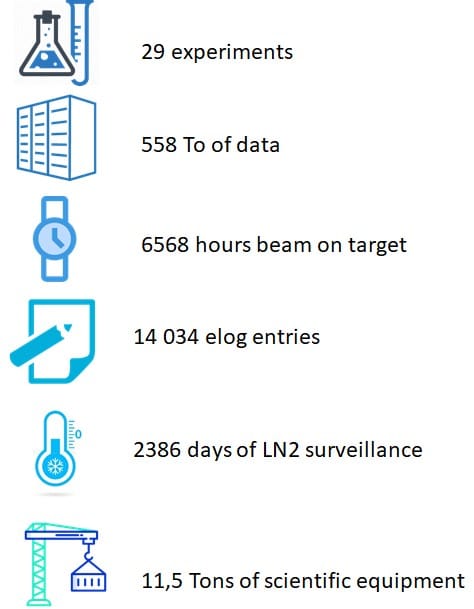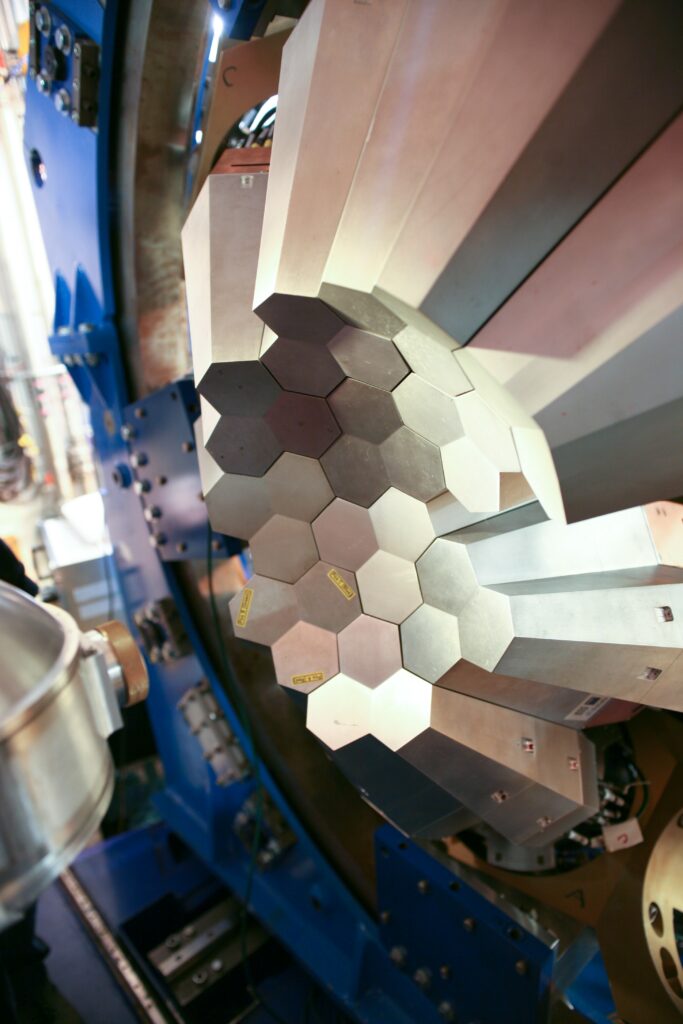- Homepage
- >
- Scientists
- >
- News & Highlights
- >
- 2021
- >
- AGATA at GANIL : seven years of success-story
News & Highlights
September 13, 2021
AGATA at GANIL : seven years of success-story

The Advanced Gamma Tracking Array (AGATA) campaign at GANIL has been successfully completed in summer 2021. The AGATA array, is the European forefront instrument based on semiconductor Germanium detectors, for high-resolution γ-ray spectroscopy in which France has a major contribution. AGATA is used in the nuclear research facilities operating presently in Europe and will be especially important for the experimental conditions expected at the future facilities for intense radioactive ion beams as well as for high-intensity stable ion beams. After successful campaigns in LNL-Italy (2010-2012) and GSI-Germany (2012-2014), AGATA was installed in June 2014 at GANIL in the G1 experimental hall coupled to the VAMOS++ spectrometer.
The installation of AGATA involved several laboratories in Europe and the coordination effort was lead by the GANIL staff. . AGATA is a cryogenic instrument at the Liquid Nitrogen temperature. The GANIL staff achieved 2386 days of continuous supply of Nitrogen and surveillance without a single accidental warm-up. To address the physics objectives, AGATA was coupled to a large variety of complementary instruments measuring light charged particle, neutron and heavy ions involving an intense coordination and technical work for the GANIL local teams. On the 6th of September 2021, 11.5 Tons of material have been packed and sent to Italy. This last step involved many collaborators and local support to achieve this milestone timely.

The spectrometer was commissioned in-beam in the autumn of 2014 and the campaign officially started in 2015. The AGATA campaign also involved a major scientific coordination for optimizing its usage. Several dedicated workshops were organized at GANIL and the scientific opportunities were intensively discussed. Four campaigns were identified in 2013 and coordinated, covering several fields in such as nuclear structure, nuclear reaction and nuclear astrophysics. Three major campaigns were scheduled between 2015 and 2021 for the spectroscopy of heavy nuclei making use of the VAMOS++ spectrometer (2015-2017 and 2021) or the NEDA-DIAMANT detectors (2018) and spectroscopy of light nuclei using reaccelerated RIB from the SPIRAL1 facility coupled to the MUGAST array (2019-2021). In these seven years, 29 in-beam experiments were performed for 6568 hours and resulted in 560 Tb of data.
The AGATA campaign provided important scientific results on a large number of topics. results In the study of the nuclear deformation in fission fragments having mass number close to 100 or in the vicinity of 208Pb. Nuclear spectroscopic studies were performed in very exotic nuclei around the magic or semi-magic 48Ca, 68Ni, 78Ni, 100Sn, 132Sn and 208Pb isotopes to tackle the evolution of nuclear structure as a function of the neutron/proton imbalance. The role of the 3-body term in the nuclear interaction was investigated in the neutron-rich Oxygen isotopes. The study of key reaction in nuclear astrophysics around the CNO cycle were investigated using stable and radioactive beams. Several high impact publications have been already published and more will come in the next years after all analysis are completed.
The AGATA project is progressing to its next phases. From 2021, the AGATA project will start its Phase2 leading to the construction of a ~3p system by 2030 for a total cost of ~29M€. Meanwhile, the collaboration will continue its scientific campaign in LNL, FAIR and GANIL. The French partners will have a major contribution in the technical and scientific project.
Picture : View of the AGATA array installed at GANIL.
Each hexagonal shape correspond to one of the AGATA
Germanium Crystal measuring with an unprecedent
accurary the photon’s emitted during the ions collision

